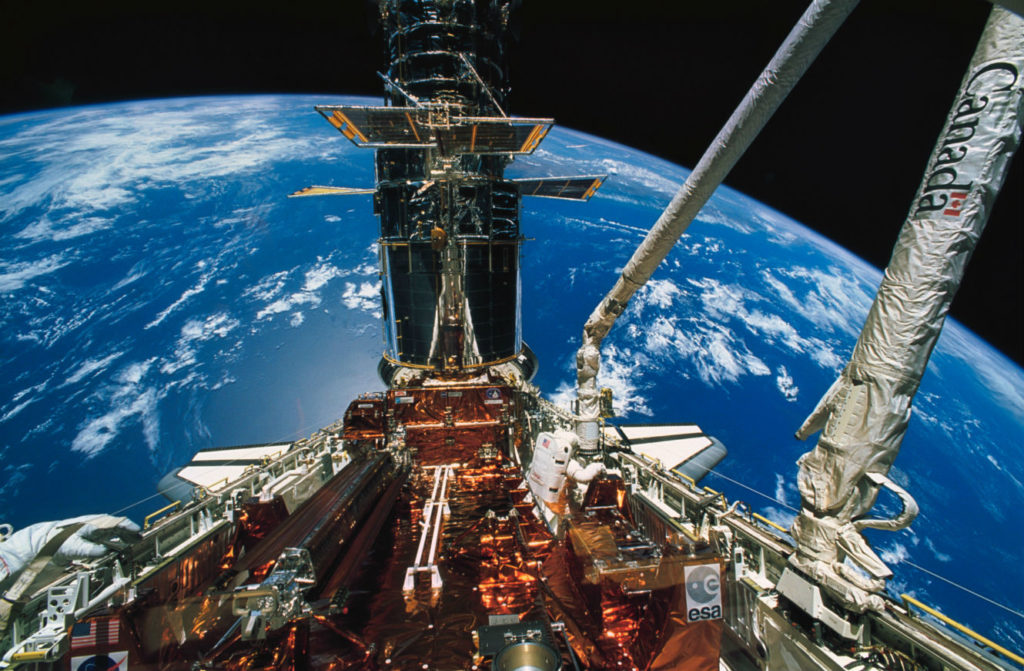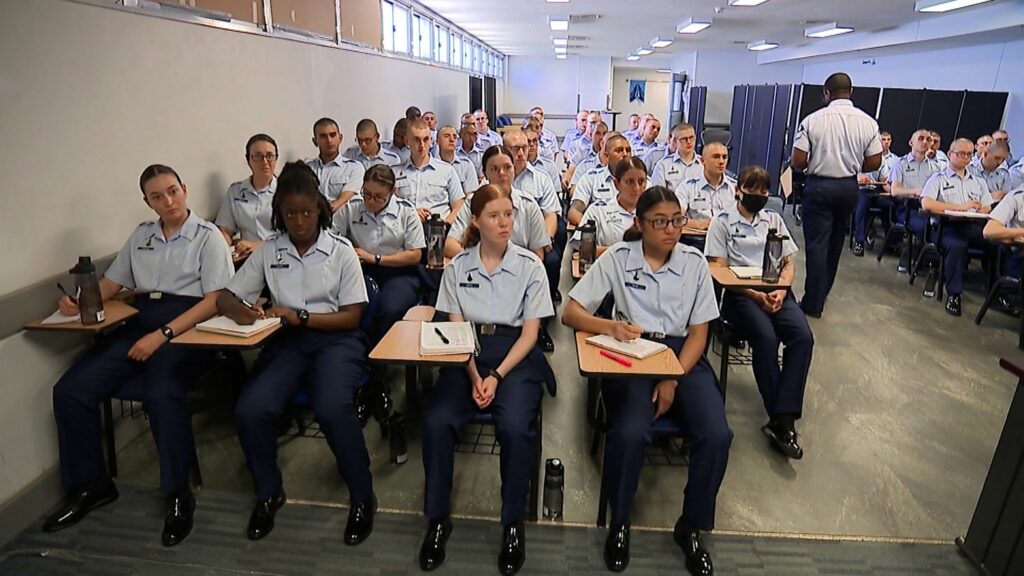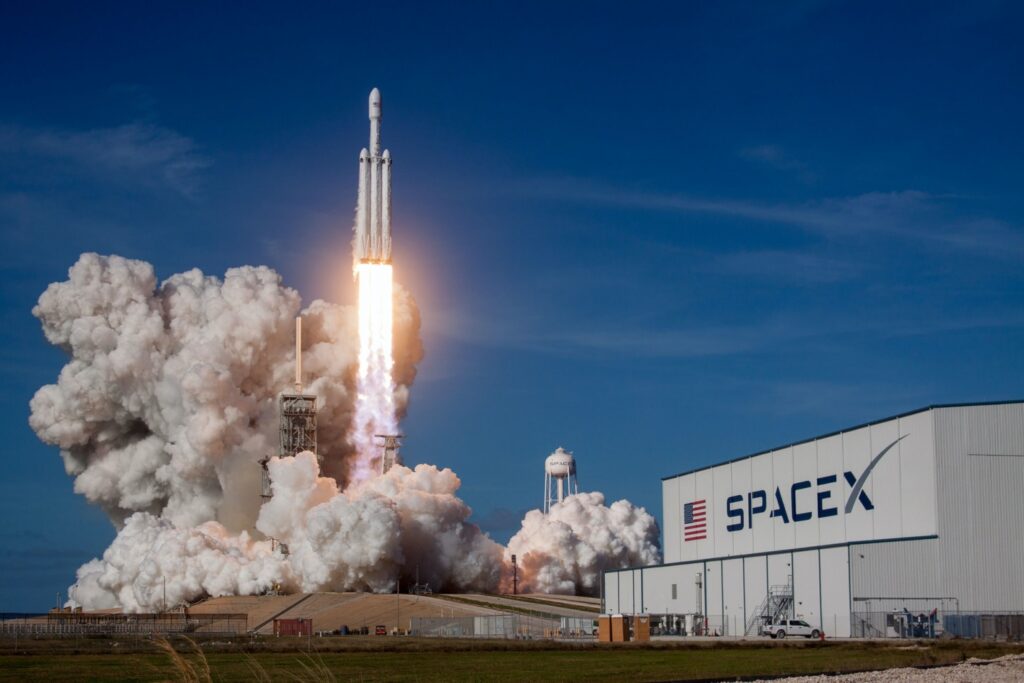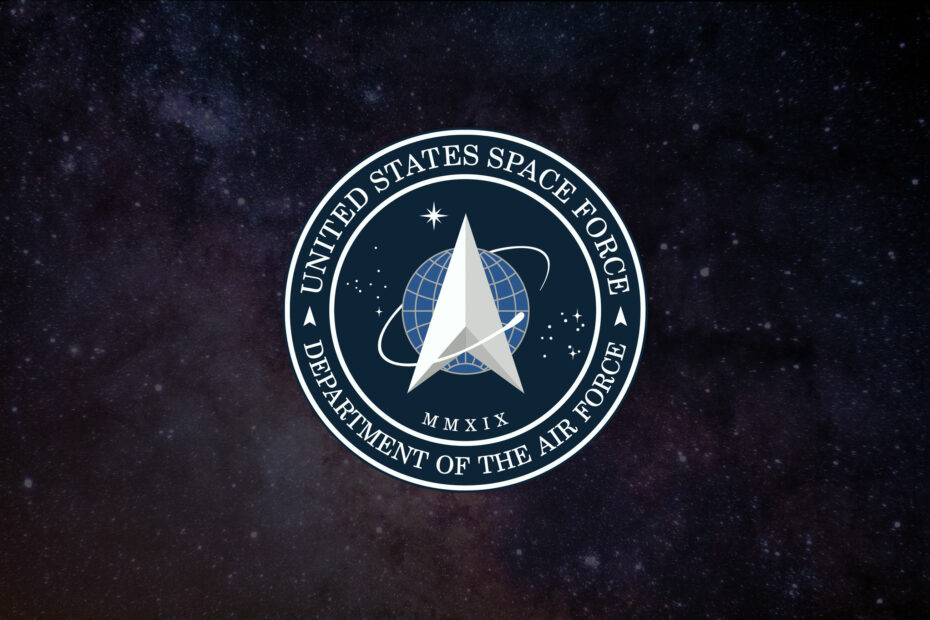Last updated on April 25th, 2023 at 06:56 am
The United States Space Force is the newest branch of the U.S. military, established in December 2019 under the Trump administration. The creation of this branch was a significant milestone in the history of space exploration and military operations. In this blog post, we will explore the role of President Donald Trump in the establishment of the United States Space Force and the current status of the branch. We will also look at the Space Force’s responsibilities, partnerships, and recent developments, including the debut of its service dress uniforms. Let’s dive into the fascinating world of the Space Force and its role in securing America’s interests in space.
What is the United States Space Force?
The United States Space Force was established on December 20, 2019, as the sixth branch of the U.S. Armed Forces by the National Defense Authorization Act. The idea for a separate space force was initially proposed by President Donald Trump in 2018, and in February 2019, he signed Space Policy Directive-4, directing the Department of Defense to create the Space Force as a separate military service within the Department of the Air Force. General John W. “Jay” Raymond was sworn in as the first Chief of Space Operations on January 14, 2020. The Space Force’s motto, “Semper supra,” is Latin for “Always above,” and its symbol, the Delta, signifies the service’s responsibilities and mission while honoring its long history that began long before its creation in 2019. The Space Force has approximately 16,000 personnel, including both military and civilian employees, and is responsible for launching and operating satellites, conducting space-based intelligence and surveillance, and developing new technologies for space exploration and defense. The Space Force has also established partnerships with other countries’ space organizations, including the United Kingdom’s Royal Air Force and the Japan Aerospace Exploration Agency. The branch of the United States Armed Forces has six locations in Buckley, Colorado; Los Angeles, California; Patrick, Florida; Peterson, Colorado; Schriever, Colorado; and Vandenberg, California.
The History of the United States Space Force:
The United States Space Force has a rich history that can be traced back to 1954 when the U.S. Air Force created a division responsible for overseeing the U.S. military’s ballistic missiles. This division underwent several changes over the following decades as the U.S. placed more satellites in orbit for communication and early missile warning systems. In 1982, the Air Force established Air Force Space Command, which became the first operational space command in the U.S. Armed Forces. As the Department of Defense (DOD) sought to consolidate its space operations, Air Force Space Command continued to expand throughout the 1980s and beyond.
In December 2019, President Donald Trump signed the 2020 National Defense Authorization Act, establishing the United States Space Force as an independent service. The Space Force is now part of the U.S. Department of the Air Force, similar to the way the United States Marine Corps is part of the U.S. Department of the Navy.
When the Space Force was created, it had 16,000 military and civilian personnel assigned to it. As of January 2023, the service consists of 4,286 enlisted service members and 4,314 officers, making it the smallest branch of the U.S. military. In 2020, service members of the Space Force were given the name “Guardians,” which was announced during a ceremony marking the service’s first anniversary.
Recently, in September 2021, the Space Force debuted its service dress uniforms. The uniforms feature a six-button double-breasted tunic, which drew comparisons to the costumes worn in the sci-fi series “Battlestar Galactica.”
The United States Space Force has several commanders who play crucial roles in overseeing various aspects of the service.
- Commander-in-Chief: President Joe Biden
- Secretary of Defense: Lloyd Austin
- Secretary of the Air Force: Frank Kendall III
- Chief of Space Operations: Gen B. Chance Saltzman
- Vice Chief of Space Operations: Gen David D. Thompson
- Chief Master Sergeant of the Space Force: CMSSF Roger A. Towberman
The Role of the United States Space Force in National Security:
The Space Force was established in 2019 as a new branch of the United States Armed Forces, with a focus on protecting American interests in space and ensuring freedom of operation in the space domain. The Space Force Act codified its missions and responsibilities, including protecting U.S. interests in space, deterring aggression, and conducting space operations.

In August 2020, the Space Force released its capstone doctrine, Spacepower: Doctrine for Space Forces, which further elaborates on its missions and core competencies. The doctrine outlines three cornerstone responsibilities for the Space Force, which include providing freedom of action in space, enabling joint lethality and effectiveness, and providing independent options to U.S. national leadership.
The Space Force identifies five core competencies, including space security, combat power projection, space mobility and logistics, information mobility, and space domain awareness. It also lists seven spacepower disciplines required for the core competencies, such as orbital warfare, space electromagnetic warfare, space battle management, space access and sustainment, military intelligence, cyber operations, and engineering and acquisitions.
Training and Recruitment in the United States Space Force:
The United States Space Force has a rigorous training and recruitment process to ensure that its personnel is well-equipped to carry out their missions and responsibilities in the space domain.
Recruitment for the Space Force is similar to other branches of the U.S. military, with potential recruits needing to meet specific eligibility requirements and undergo a rigorous selection process. This includes meeting age, education, and physical fitness requirements, as well as passing a medical examination and background check.

Once recruited, Space Force personnel undergo specialized training to prepare them for their roles in space operations. This training includes both classroom instruction and hands-on experience with space systems and technologies. Space Force personnel also receive training in areas such as orbital mechanics, space debris mitigation, and space situational awareness.
The Space Force also has several ongoing education and training programs to ensure that its personnel stays up-to-date with the latest technologies and developments in the space domain. This includes professional development opportunities, continuing education programs, and joint training exercises with other branches of the military and allied nations.
The United States Space Force and International Space Law:
The United States Space Force (USSF) was established on December 20, 2019, as the sixth branch of the United States Armed Forces. As a military branch focused on space operations, the USSF has a significant role in ensuring the United States compliance with international space law.
International space law is a body of law that governs the use and exploration of outer space. The main framework for international space law is the Outer Space Treaty of 1967, which provides guidelines for the peaceful use of space and prohibits the placement of weapons of mass destruction in space. The United States is a party to this treaty, as well as other international space agreements, such as the Agreement on the Rescue of Astronauts, the Return of Astronauts and the Return of Objects Launched into Outer Space (the “Rescue Agreement“), and the Convention on Registration of Objects Launched into Outer Space.
As a military branch, the USSF must comply with these international space agreements while fulfilling its mission of defending the interests of the United States in space. This means that the USSF must ensure that its space operations are conducted in a manner consistent with international space law, including the principles of peaceful use and non-aggression. Additionally, the USSF must comply with the provisions of the Rescue Agreement, which obligates parties to provide assistance to astronauts in distress and to return astronauts and space objects to their country of origin.
The USSF is also responsible for protecting United States space assets and interests, including satellites and other space-based technologies. This mission requires the USSF to engage in activities such as space situational awareness, satellite defense, and offensive operations, which may have implications for international space law.
Technological Advancements in the United States Space Force:
The United States Space Force (USSF) is a branch of the United States Armed Forces responsible for space warfare. As a relatively new branch, the USSF is focused on developing and utilizing advanced technologies to maintain superiority in space operations. Some of the technological advancements in the United States Space Force include:
Advanced Satellites:
The USSF relies heavily on advanced satellite technology for communication, surveillance, and navigation. The development of advanced satellites that can operate in contested environments is a top priority for the USSF. These satellites are equipped with advanced sensors and encryption technology to ensure secure communication.
Space-Based Sensors:
The USSF is developing advanced space-based sensors to detect and track enemy satellites and other space-based threats. These sensors will provide early warning of potential attacks and enable the USSF to take defensive measures.
Space-Based Lasers:
The USSF is working on developing space-based laser weapons that can be used to destroy enemy satellites or other space-based threats. These weapons have the potential to provide a low-cost and highly effective means of defending U.S. assets in space.
Autonomous Spacecraft:
The USSF is developing autonomous spacecraft that can operate without human intervention. These spacecraft will be capable of performing a range of tasks, including surveillance, communication, and maintenance.
Cybersecurity:
The USSF is developing advanced cybersecurity measures to protect its space-based assets from cyber attacks. This includes developing advanced encryption technology and protocols to ensure secure communication.
Artificial Intelligence:
The USSF is exploring the use of artificial intelligence to improve its space-based operations. This includes using AI to analyze large amounts of data from space-based sensors and satellites to identify potential threats.
The Future of the United States Space Force: Predictions and Prospects for Space Warfare
The future of the USSF, the space domain will likely become increasingly important for national security, commerce, and exploration, and the USSF will play an important role in these areas. Some potential areas of focus for the USSF in the coming years could include:
Space-Based Surveillance and Intelligence:
The USSF could expand its efforts to develop and deploy space-based sensors and intelligence-gathering systems to provide situational awareness and early warning of potential threats to U.S. space assets.
Space-Based Communications:
As reliance on space-based communications systems continues to grow, the USSF may play a key role in protecting these systems from cyber threats and other attacks.
Space-Based Navigation:
The USSF could also play a role in developing and maintaining space-based navigation systems that are critical for military and civilian applications, such as GPS.
Space Exploration:
As the United States continues to pursue ambitious space exploration goals, such as returning to the Moon and sending humans to Mars, the USSF may be called upon to provide support and protection for these missions.
The United States Space Force Science, Technology, and Research Directorate and the United States Coast Guard Research and Development Center signed a memorandum of understanding on January 19th to enhance space capabilities for the joint warfighter. This marks the first time the two organizations have worked together, and the partnership will focus on collaboration and transparency to enhance capabilities and technologies, share best practices, and optimize the development and transition of future space capabilities to the joint force. The organizations aim to take advantage of each other’s expertise to maintain the U.S.’s technological edge and a strong foothold in space.
The United States Space Force and Private Space Companies: Collaboration or Competition?
The United States Space Force and private space companies, such as SpaceX and Blue Origin, are currently in a complex relationship that involves both collaboration and competition. While the Space Force is responsible for protecting U.S. interests in space and developing new technologies for national security purposes, private space companies are focused on commercial space activities and exploration. However, the two entities have overlapping interests and capabilities, leading to partnerships on projects such as launching military satellites and conducting research on space technologies. At the same time, private space companies are also competing with the Space Force for government contracts and access to launch facilities. Overall, the relationship between the Space Force and private space companies is a constantly evolving one, driven by both shared goals and competitive pressures.

The United States Space Force and NASA: Partners in Space Exploration
The United States Space Force (USSF) and NASA have a long history of collaboration in space exploration, dating back to the early days of the space program. While the two organizations have distinct missions and objectives, they have worked together to achieve common goals and advance the nation’s space capabilities.
One example of collaboration between the USSF and NASA is the use of the Space Launch Complex 41 at Cape Canaveral Space Force Station in Florida, which is jointly operated by the two organizations. This launch complex has been used for many important space missions, including the Mars 2020 Perseverance rover mission, which was launched in July 2020.
The USSF and NASA also collaborate on research and development of new technologies for space exploration. For example, the USSF’s Space and Missile Systems Center partnered with NASA’s Jet Propulsion Laboratory to develop a deep space atomic clock that could improve the accuracy of spacecraft navigation and communication.
In addition, the USSF provides support to NASA by providing range safety and space surveillance services during launches and other space operations. The USSF’s Space Delta 2, which is responsible for space-based missile warning and space situational awareness, works closely with NASA to ensure the safety of spacecraft and crew during space missions.
Military Objectives and Space Sustainability:
One of the primary objectives of the Space Force is to maintain and enhance the freedom of operation in space for the U.S. and its allies. This includes protecting U.S. and allied space systems from physical, electronic, and cyber attacks, as well as ensuring the ability to deny adversaries the use of space-based assets for hostile purposes.
In addition to its military objectives, the Space Force also recognizes the importance of space sustainability. As more and more countries and commercial entities launch satellites and other objects into space, there is a growing risk of collisions and debris that could threaten the safety and stability of the space environment.
To address this, the Space Force is committed to promoting responsible behavior in space and working with other nations and organizations to establish best practices for space sustainability. This includes collaborating with NASA, the National Oceanic and Atmospheric Administration, and other entities to track and mitigate orbital debris, as well as supporting international agreements and guidelines such as the United Nations Space Debris Mitigation Guidelines.
Establishment of United States Space Force and Former President Donald Trump:
The United States Space Force was officially established as the sixth branch of the U.S. military on December 20, 2019, under the administration of former President Donald Trump. Trump was a vocal advocate for the creation of the Space Force, citing the importance of maintaining American dominance in space and protecting the country’s assets in orbit.
During his tenure, Trump made several public appearances with Space Force officials and touted the branch as a crucial component of his administration’s national security strategy. He also authorized funding for the development of new space technologies and capabilities, including the creation of a new Space Command headquarters.
Donald Trump, the 45th President of the United States, played a significant role in the creation and development of the United States Space Force. Here are some key highlights:
Announcement of Space Force:
On June 18, 2018, President Trump announced the creation of a new branch of the military, the United States Space Force, during a meeting of the National Space Council.
Establishment of Space Force:
On December 20, 2019, President Trump signed the National Defense Authorization Act for Fiscal Year 2020, which included the establishment of the United States Space Force as the sixth branch of the U.S. military.
Space Policy Directives:
President Trump issued several Space Policy Directives during his presidency, including SPD-1, which directed NASA to return humans to the moon, and SPD-4, which called for the establishment of a U.S. Space Force.
Space Force Leadership:
President Trump nominated General John W. Raymond to be the first Chief of Space Operations, a four-star general who would lead the United States Space Force. Gen. Raymond was confirmed by the Senate on December 20, 2019.
Space Force Operations:
Under President Trump’s leadership, the United States Space Force began its operations on December 20, 2019. The Space Force is responsible for protecting U.S. interests in space, including communications, navigation, and reconnaissance.
Budget and Expansion:
During his presidency, President Trump allocated $15.4 billion to the United States Space Force and called for its expansion. The Space Force currently has over 6,000 personnel and is expected to continue growing in the coming years.
Bottom Line:
The establishment of the United States Space Force (USSF) represents a significant milestone in the history of space exploration and military operations. The USSF was officially created on December 20, 2019, as the sixth branch of the United States Armed Forces, with the primary mission of protecting U.S. interests in space and deterring aggression against American assets in orbit.
The USSF was created in response to the increasing importance of space-based operations, including communications, navigation, reconnaissance, and surveillance. As the use of space becomes more widespread and important for military and civilian purposes, the United States recognizes the need to prioritize the protection of its space assets and interests.
Since its creation, the USSF has made significant progress in developing its organizational structure, recruiting personnel, and establishing partnerships with other U.S. military branches and allies. The USSF has also been involved in several high-profile space missions, including the launch of the X-37B spaceplane and the deployment of new GPS satellites.
